For some tourists, seeing the giraffe-like, long neck women Kayans may seem like just another stop on a Thailand adventure of a lifetime.
Many tourist agencies stop by these hill villages between jeep rides through snake-infested jungles and tours of elegant temples.
Visitors pile out for a quick photo opportunity with exotic-looking women before tour guides shuttle the group to the next destination.
Who are these women?
And should you support this controversial tourism attraction?
Who Are The Kayans?
Two decades ago, an intensifying civil war between Karenni separatists and the Burmese army caused Kayar residents to flee Myanmar.
Thailand granted the Kayan temporary stay under “conflict refugee” status.
Now, the 500 or so Kayans (also known as Padaung people) live in guarded villages on the northern Thai border.
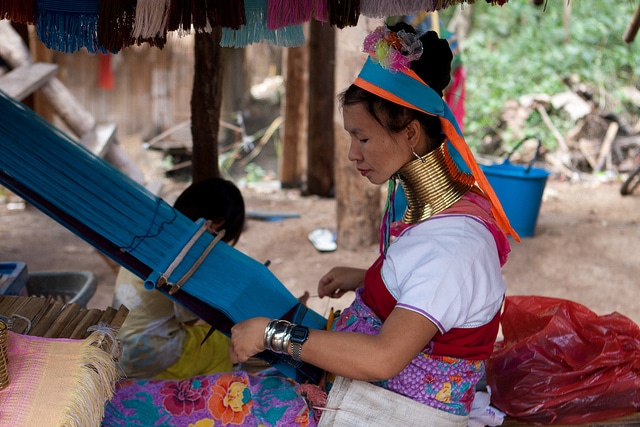
The tribe has a custom where some women wearing rings to create the appearance of a long neck.
This exotic tradition inspired the creation of tourism villages in 1985.
Some Padaung moved to these artificial hill tribe residencies with work permits to make a living on tourism.

But without citizenship, Kayans have limited access to utilities such as electricity, roads, health care and schools for education.
Furthermore, Thai authorities refuse to allow Kayans to resettle outside tourist villages, claiming they are economic migrants and not real refugees.
The Rings
Kayan long neck women wear the rings from childhood, starting with four or five, and adding more annually as they acclimate to the increased weight.
Coils weighing up to 25 pounds depress the chest and shoulders.
This creates the illusion of disembodied head hovering over a shimmering pedestal of gold rings.
Contrary to popular belief, the coils don’t lengthen the neck itself and thus can be removed without the neck snapping.
Yet, women still wear these coils year round with few exceptions, even while sleeping.
The origin of the tradition mystifies even the Kayans.
An ancient legend claims rings protected villagers from tiger attacks since the cats attack victims at the neck.
Another theory said the rings helped ward off men from rival tribes by lessening the women’s beauty.
Today, people believe the opposite — the longer their neck, the more beautiful the woman — and Kayans wear the golden coils as an accessory.
According to the Silent Hopes documentary (shown above), some women enjoy upholding this tradition but others feel pressured to endure the painful custom to make a living.
Human rights groups claim the refugee status exploits women who can’t find other work.
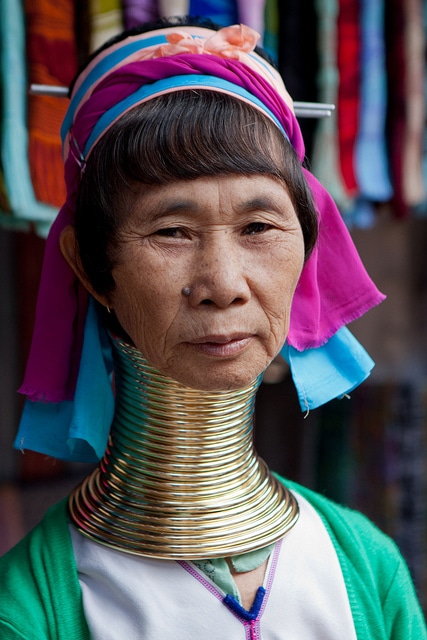
Hill Tribe Tourism
An estimated 40,000 tourists per year pay between $8-16 to stop by these hill tribe villages to gaze upon the women’s unusual appearance and take pictures.
Unfortunately, the entry fee is rarely dispensed to the villagers directly. Instead, neck-ring-wearing-women sell trinkets, crafts, and photo-ops, essentially working in a live-in gift shop.
Residents receive an allowance of food and toiletries and profit from handicraft sales, and women wearing brass rings earn an extra salary.
Village owners decrease wages if women discuss their plight with visitors or use anything modern, like cell phones or computers.
While some say the villages give Kayans a paid opportunity to retain their culture, others condemn this arrangement for exploiting stateless women and children in exchange for tourist dollars.
Although the ethics of this arrangement makes some travelers uncomfortable, each day, vanloads of curious foreigners still visit long neck villages.
Many foreign-run companies discourage these trips but most Thai-based companies don’t discriminate.
Over a half-dozen hill tribes exist in North Thailand and the Chiang Mai province.
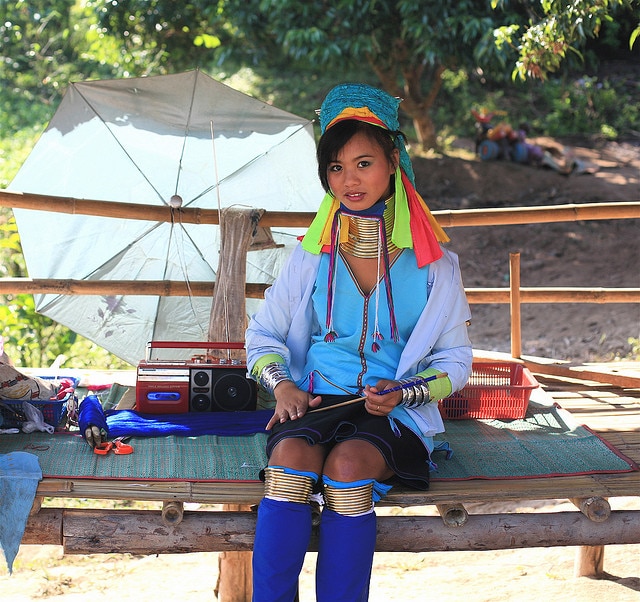
Should You Go?
Can you justify ethical travel to these villages?
Yes, if you do your research.
Most women view tourist visits as a way to make a living since their non-resident status limits employment opportunities; however, sensationalizing dress, customs, and unique traditions of these people mean nothing if they are treated inhumanly.
If you chose to visit, follow these recommendations to make it a better experience:
- Do your research and find a responsible tour company that will promote a socially responsible visit. Private guides can bring you to their own villages.
- Make sure your money benefits the village directly instead of third-party companies. If you’re not sure, insist you give money to the chief of the village or support the women by purchasing their handicrafts.
- Don’t just stop by for a photo shoot. Try to extend your stay to learn about the people and hear their stories.
- Consider volunteering in a village- Border Green Energy Team can arrange such an opportunity.
The goal of travel shouldn’t be taking pictures of exotic things to brag about back home.
Travel is about forging relationships and making connections with people from different cultures.
Create a symbiotic relationship with locals by reaching out to find common ground with the people you met, instead of treating them as spectacles to exploit.
Ethica Thailand Tours
Want to take part in tours that benefit local people? Check out Lokal Travel’s positive impact excursions in Thailand. Some suggestions include:
Spread the word & pin this post for later!
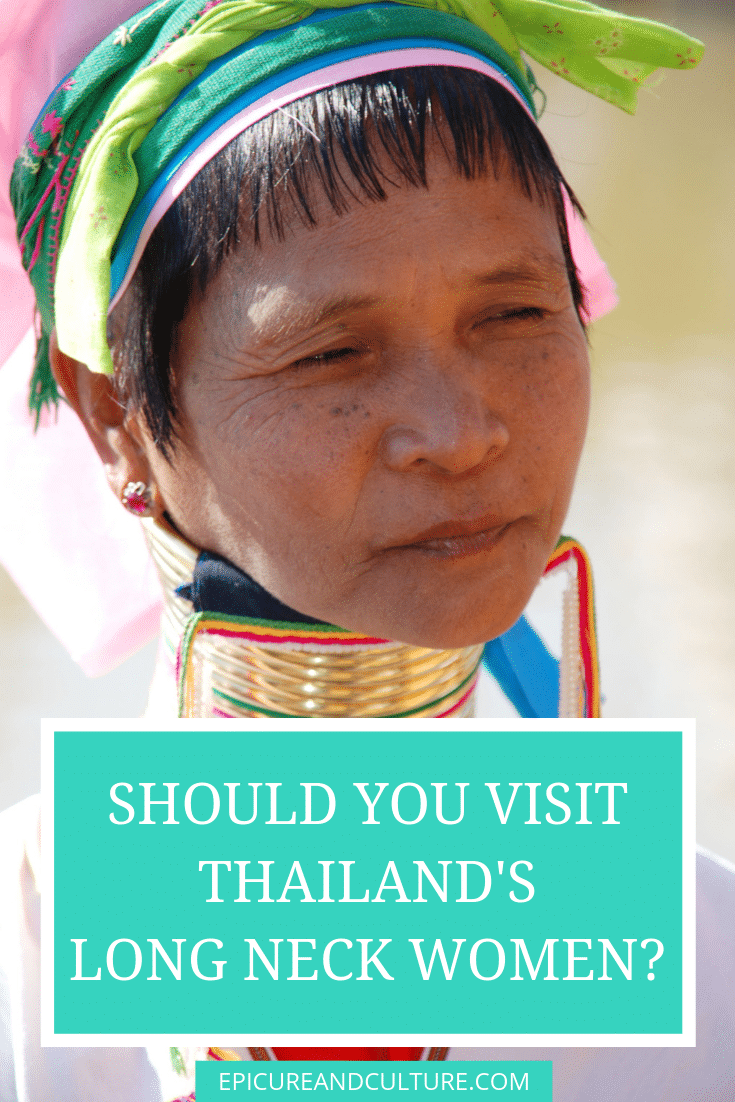 |
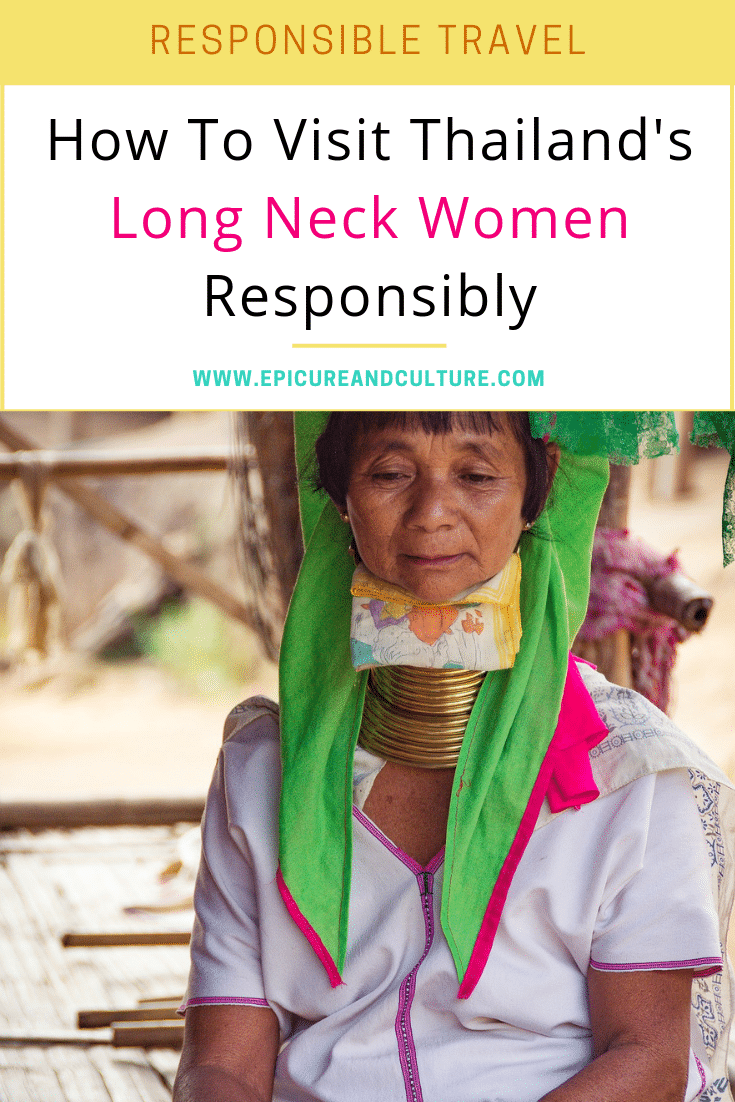 |
Katie Foote
Latest posts by Katie Foote (see all)
- 8 Outstanding Conservation Safaris Around The World - Apr 12, 2022
- These 10 Women Whiskey Distillers Will Make You Crave A Manhattan - Dec 12, 2018
- Ethical Travel: Should You Visit Thailand’s Long Neck Women Villages? - Dec 9, 2018
- 8 Pioneering Vegetarian Vacations Around The World - Aug 13, 2018
- A New Perspective: Can Travel Help Reverse Alzheimer’s? - Aug 5, 2018






That was a really interesting article, Katie. I haven’t been to that part of the world yet but I can imagine myself being interested in those cultures and tribes if/when I go. Nice to understand some background about them and their presence there, and hear both sides of the tourism story. 🙂
Really I enjoy your site with effective and useful information. It is included a very nice post with a lot of our resources. Thanks for sharing. I enjoy this post
Thanks for this article.
I am currently doing research since I really want to visit hill tribes in Northern Thaïland and I just don’t want to do it wrong.
Now I’ll go on the search for a long stay in one of those villages 🙂
Katie, after reading your last paragraph I’d love to know why you suggest that visiting villages like this is ethical.
I have just read Martin Stevenson’s ‘Leave only footprints’ where he draws a completely different conclusion. These villages have been described as ‘human zoos’ by the UNHCR.
Tourism Concern and Martin highlight the plight of 20 Kayan women who were refused exit visas which would have allowed them to settle overseas under an UNHCR scheme. The suggestion is that the business men who take the bulk of the entry money to these villages didn’t want to lose their nice little earner. The women have been falsely informed that their necks will break if they remove the rings.
Pretty nearly everyone in the world needs money, is this a valid argument in this case? It seems that at first the Thai Government weren’t too concerned about their plight but then it found a way of making money from the Padaung. Is the government afraid that if they give them rights as citizens that they families would pursue education to higher grades and find employment in other fields than posing for tourists?
This story is worthy of more detailed research for readers to make their own minds up on this matter.
http://www.tourismconcern.org.uk/index.php?page=news/132/154/Kayan-museum-ordered-to-close.html
http://www.tourismconcern.org.uk/index.php?page=news/29/154/Burmese-refugees-trapped-by-tourism.html
@John: Great questions. Thank you so much for the additional resources.
Such a great article. I visited a Kayan village in December and made sure to only purchase directly from the Kayan women. They are amazing people. All survivors….
@Ruji: Thank you for the kind words. Very true…
Great article. Never thought about it that way. We will be there in 2 weeks and will try to follow your tips to make it the most of it always respecting their culture.
Oh thank you very much for the article! I thought was alone thinking the “unhumanity” of this Rings and all the Women that i saw in this Village were really beautiful but such a Sad Looking, and i try to talk to them but they were looking scare and pretending not to understand english! I think this Women should be from the Human Right Organisation protected! What i see there was not pure Tradition but was pure Dishonest for Women and pure Bussines who someone else take the big amounts!
Thanks for the insight. We presently are in Chiang Mai and were seeing there tours offered and did our research. This totally unacceptable . Let’s accept people as refugees and give them rights without taking advantage of them. This is definitely not one activity we will be a part of. Human dignity first.
Interesting. I visited Thailand but I had no idea about this. Thanks for sharing.
wow, this is incredible. It is nice to see other cultures appreciated. Those coils around the neck look nice but yet so mysterious.
It must be really fascinating to be in one of these villages. Amazingly unique culture. Would love to be there sometime. Great Work!
Furthermore, It ought to be CD-quality music, clear and smooth to pay attention to. 4. It ought to have free help. The download webpage ought to be accessible day in and day out, prepared to help you in the eve, I can say that with the 15 billion records they offer, it’s overpowering. They truly make it simple for their individuals to rapidly discover any melody or film. You can move a document to your PC and copy limitless CDs
Wow I’m shocked
Is that teabag rope or what?????
Very interesting how the girls are stucked with those rings on neck…
The girls wear those rings on necks all the time, its very interesting
Very interesting fact and tradition.
This is very interesting fact and tradition.
Going to visit as soon as the pandemic ends. Planning to travel to Bali and Thailand. Looking forward to it. Much appreciated this interesting share
it’s really interesting article, thank you so much for sharing this us.
Leave your stress and go on 18 days long Kanchenjunga circuit trek
Thank you for sharing this interesting information about Thailand. I had no idea that this was the case. I visited Thailand a few years ago and it was a great experience.
This is a very cool tradition. It is good to know their background and understand more about them. Love your content! Please share more! <3
Interesting read. Hope you keep up the good work! Intoptrend
Intoptrend
One hour to change your health and life. Healing hands, compassionate hearts, & intuitive minds!
Excellent Work you did my dude! I came across your amazing site and found your site very informative during the search results. I bookmarked it in order to read your other articles later. Thanks for sharing such valuable content.
Osaki Massage Chair
Thank you for sharing this interesting information about Thailand. I had no idea that this was the case.
STORY Hospitality owns and works exceptional properties in laid out key traveler objections all over the planet. Submerged in the neighborhood local area, we as a group are enthusiastic about building and keeping up with trusted and financially economical partner connections.
Interesant cum acele fete/femei poarta acele inele la gat de mici…